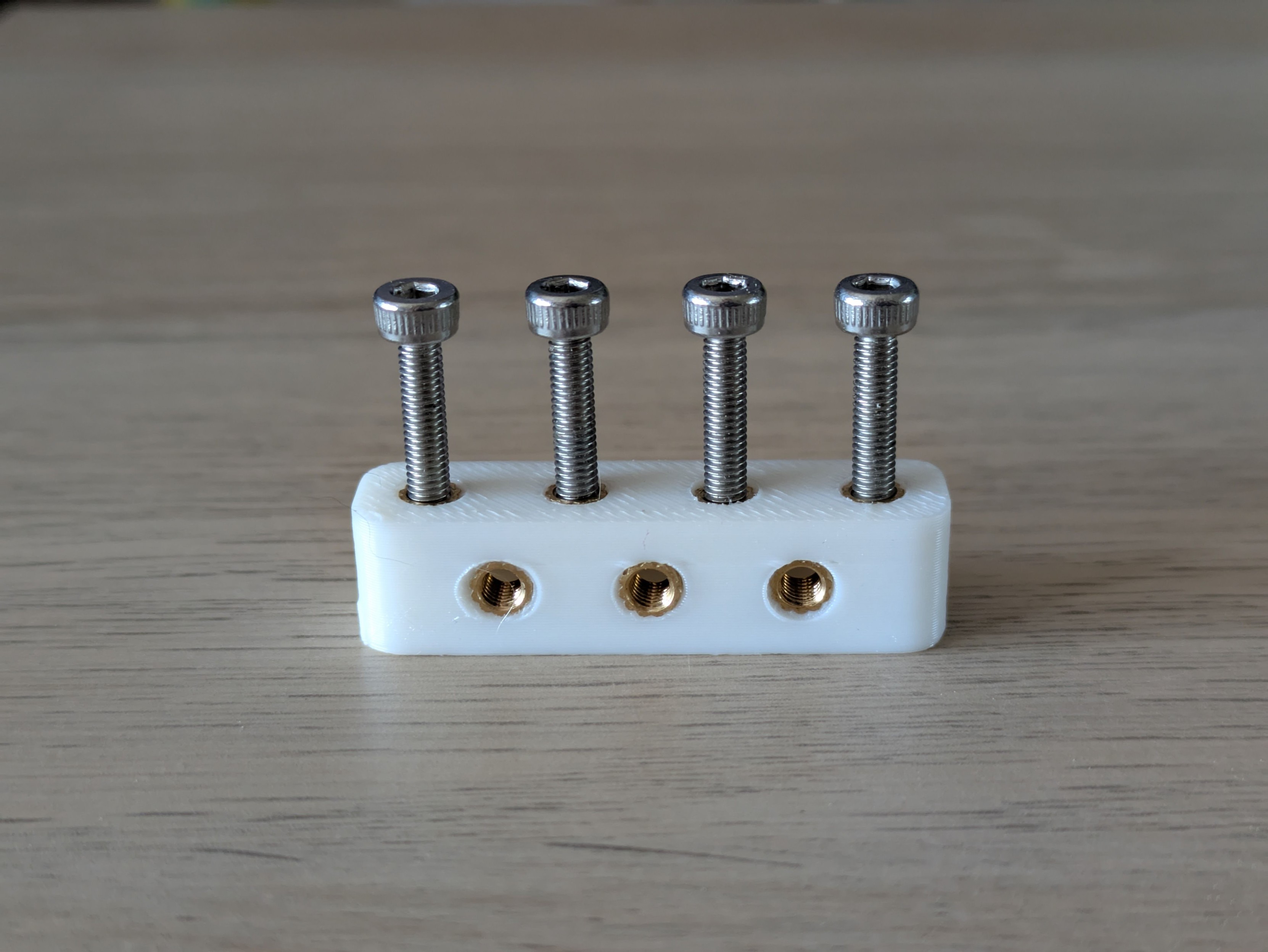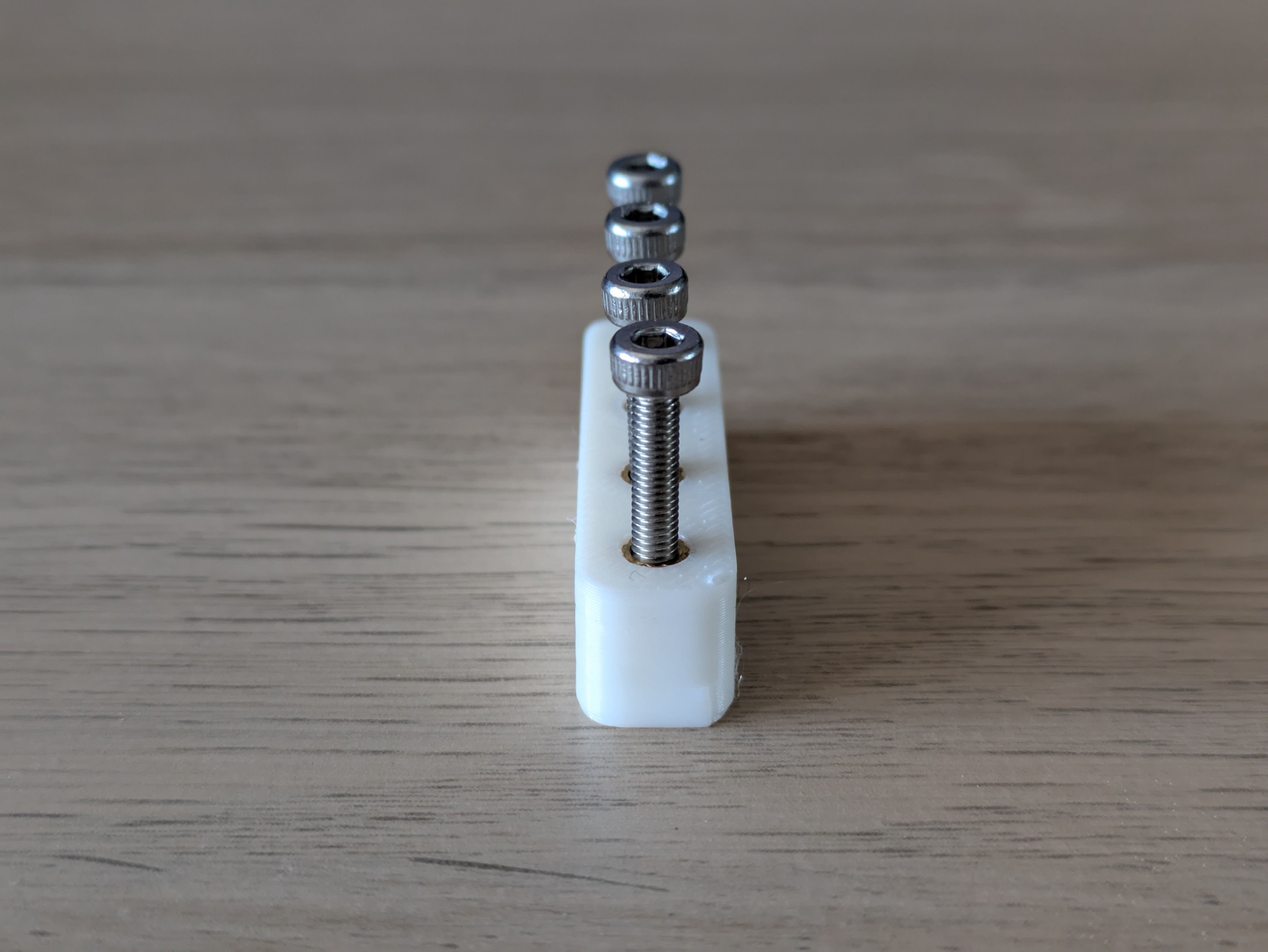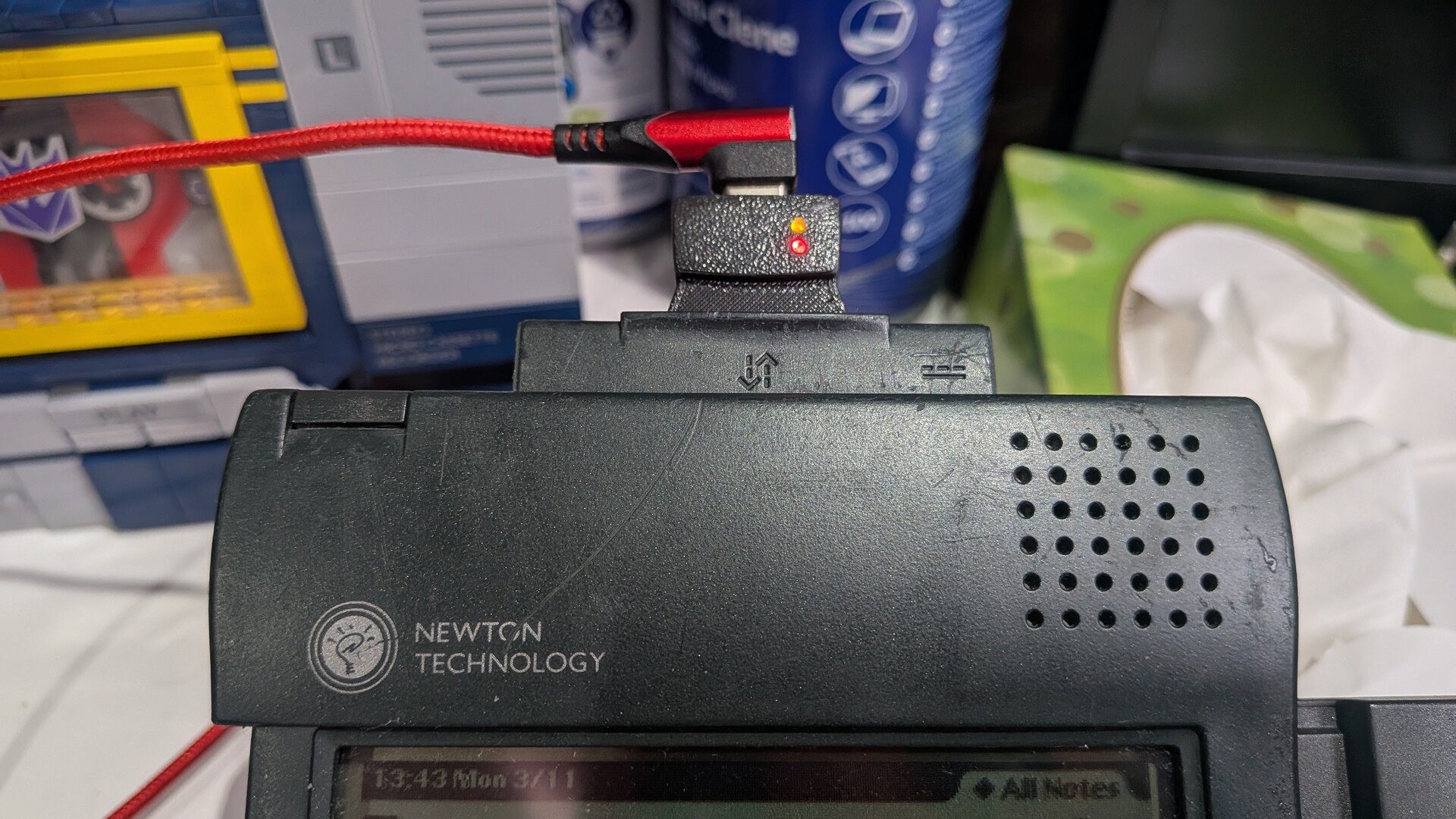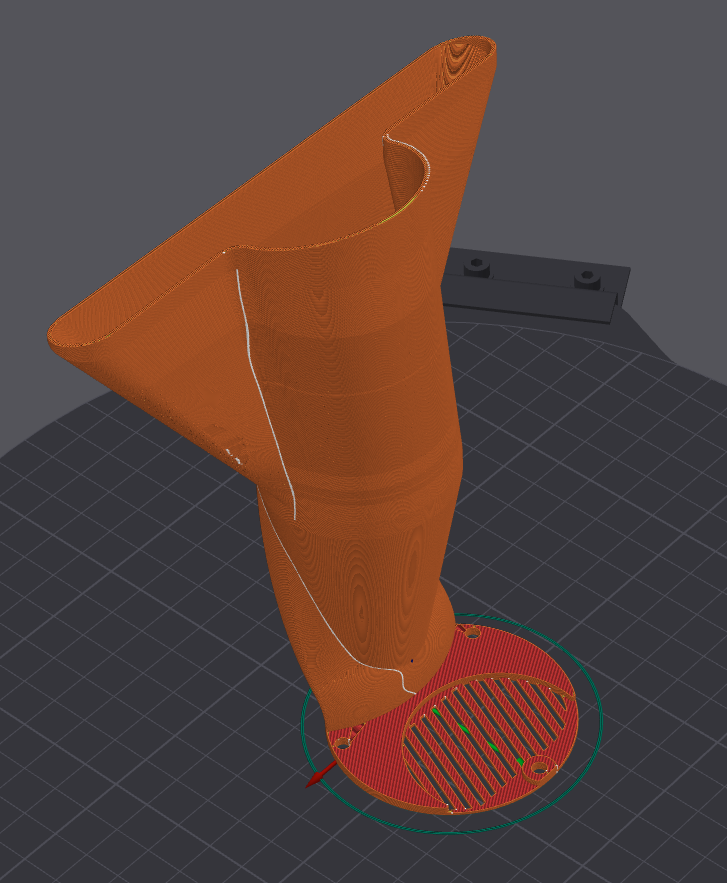Trying out some more heat-set insert timfoolery.
-
Trying out some more heat-set insert timfoolery. This is the first time I've tried it with the lightweight Pinecil soldering iron - doing it by hand, I can get way better results with that than with my old, big, heavy iron, and these should be good enough for small project mounts.
Still think it'll be worth building a parallelogram jig for doing lots of them accurately at once, but with okay results by hand I can push on with the retro PC case this week. #3DPrinting
And this is how I'm doing it - that's a specially shaped tip on the end for making contact with inserts and pushing them in flat. You *can* do this with a regular soldering iron, but you need to design your part to have enough space behind the insert for the rest of the soldering tip to go in without contacting plastic.
-
And this is how I'm doing it - that's a specially shaped tip on the end for making contact with inserts and pushing them in flat. You *can* do this with a regular soldering iron, but you need to design your part to have enough space behind the insert for the rest of the soldering tip to go in without contacting plastic.
Check out this absolutely cursed hinge idea I had - two parts, each with two threaded inserts, and a grub screw bolting them together through the middle.
This was the worst of both worlds for a hinge - finnicky enough that only one of them worked because of slightly misaligned inserts, and it has enough play in it that it's as bad as the worst hinge I tried with a real ball bearing.
Don't get me wrong, it does work as a hinge - but it's not reliable to make, and not very precise. #3DPrinting
-
Check out this absolutely cursed hinge idea I had - two parts, each with two threaded inserts, and a grub screw bolting them together through the middle.
This was the worst of both worlds for a hinge - finnicky enough that only one of them worked because of slightly misaligned inserts, and it has enough play in it that it's as bad as the worst hinge I tried with a real ball bearing.
Don't get me wrong, it does work as a hinge - but it's not reliable to make, and not very precise. #3DPrinting
I actually think that if I had been more precise in adding the threaded inserts, it'd be wobblier as a hinge - the free play in the mechanism I think comes from the fact that cheap M3 screws and threads are not precision parts, so having better aligned inserts would actually give it more room to move.
I wonder now if just hammering a steel pin through matching holes in printed parts wouldn't make for an okay hinge. Or pressing a chicago screw in and working the joint until it loosened.
-
I actually think that if I had been more precise in adding the threaded inserts, it'd be wobblier as a hinge - the free play in the mechanism I think comes from the fact that cheap M3 screws and threads are not precision parts, so having better aligned inserts would actually give it more room to move.
I wonder now if just hammering a steel pin through matching holes in printed parts wouldn't make for an okay hinge. Or pressing a chicago screw in and working the joint until it loosened.
Once again, having an accurate, reliable 3D printer disperses another iota of the scarcity mindset complex.
Or: Look! When you print vertical holes with a 5.25mm inner diameter, they perfectly fit a 5mm chicago screw - and you can use this fact to build up a long flexible chain of parts.
It's not my beloved plasbeams, but I guess a more lightweight system is better for a lightweight soldering iron.
Time to expand this out to longer beams and see how it goes.
-
Once again, having an accurate, reliable 3D printer disperses another iota of the scarcity mindset complex.
Or: Look! When you print vertical holes with a 5.25mm inner diameter, they perfectly fit a 5mm chicago screw - and you can use this fact to build up a long flexible chain of parts.
It's not my beloved plasbeams, but I guess a more lightweight system is better for a lightweight soldering iron.
Time to expand this out to longer beams and see how it goes.
The principle I'm working with here is that opposite sides of a parallelogram are always held parallel, no matter what the internal angles are, so if you build a series of them locked together, you get a machine that extends and moves freely in two dimensions, but always keeps the end exactly parallel with the start - which is exactly what you'd want from a wall- or stand-mounted mechanism for holding a soldering iron perfectly level.
I have more chicago screws and washers coming. #3DPrinting
-
The principle I'm working with here is that opposite sides of a parallelogram are always held parallel, no matter what the internal angles are, so if you build a series of them locked together, you get a machine that extends and moves freely in two dimensions, but always keeps the end exactly parallel with the start - which is exactly what you'd want from a wall- or stand-mounted mechanism for holding a soldering iron perfectly level.
I have more chicago screws and washers coming. #3DPrinting
This is not permanent as I don't have long enough screws to hold it together, but this is already an unexpectedly pleasing object to handle. These beams have a 1x1cm cross-section and are absolutely rigid enough to keep the far ends parallel no matter what. This feels like the kind of thing you'd find in a classroom to demonstrate how geometry works.
-
This is not permanent as I don't have long enough screws to hold it together, but this is already an unexpectedly pleasing object to handle. These beams have a 1x1cm cross-section and are absolutely rigid enough to keep the far ends parallel no matter what. This feels like the kind of thing you'd find in a classroom to demonstrate how geometry works.
Modelling something in 3D is such a simple joy for me. It's the ultimate mastery of computing - to perfectly reproduce a physical object in the virtual world. This is the reason I own a quality digital caliper.
This is an accurate 3D model of the soldering iron I plan to use in my threaded insert jig. I could've just made this a couple of dull rectangular blocks, but this will help me orient and scale an actual thing within the space of a project, not just line up some dots and tick a box. #CAD
-
Modelling something in 3D is such a simple joy for me. It's the ultimate mastery of computing - to perfectly reproduce a physical object in the virtual world. This is the reason I own a quality digital caliper.
This is an accurate 3D model of the soldering iron I plan to use in my threaded insert jig. I could've just made this a couple of dull rectangular blocks, but this will help me orient and scale an actual thing within the space of a project, not just line up some dots and tick a box. #CAD
Five iterations later, here's my mount for a Pinecil soldering iron.
The iron slots securely in place and is held by pressure on its rubber grip. Future cable management will stop it falling if it manages to wiggle out. It'll be mounted to the carriage by two M3 screws, so people with different irons can still use this system. Those screw mounts are chamfered, so it's self-centring and self-leveling on the carriage. And an inset arrow printed in a different colour makes the orientation obvious.
-
Five iterations later, here's my mount for a Pinecil soldering iron.
The iron slots securely in place and is held by pressure on its rubber grip. Future cable management will stop it falling if it manages to wiggle out. It'll be mounted to the carriage by two M3 screws, so people with different irons can still use this system. Those screw mounts are chamfered, so it's self-centring and self-leveling on the carriage. And an inset arrow printed in a different colour makes the orientation obvious.
The soldering iron mount being held by two screws also means it'll be trivial to undo the top screw and swivel the mount so it's being held at an angle. That won't be useful for pressing threaded inserts into prints, but someone requested that as an accessibility feature to make actual regular soldering easier - this whole arrangement will make holding and manoeuvring the iron take much less force and energy.
The model below is just a quick sketch of that to get a feel for proportions.
-
The soldering iron mount being held by two screws also means it'll be trivial to undo the top screw and swivel the mount so it's being held at an angle. That won't be useful for pressing threaded inserts into prints, but someone requested that as an accessibility feature to make actual regular soldering easier - this whole arrangement will make holding and manoeuvring the iron take much less force and energy.
The model below is just a quick sketch of that to get a feel for proportions.
The 3D printed soldering iron mount in prototype form. This camera stand is too high for its current length, it was just a convenient way to attach it to my desk.
It turns out chicago screws are a great way to make a hinge for a 3D print. This thing moves around naturally with almost no resistance at all, and once I get the proper length screws and washers involved this should be a very long-lasting mechanism. #3DPrinting
-
The 3D printed soldering iron mount in prototype form. This camera stand is too high for its current length, it was just a convenient way to attach it to my desk.
It turns out chicago screws are a great way to make a hinge for a 3D print. This thing moves around naturally with almost no resistance at all, and once I get the proper length screws and washers involved this should be a very long-lasting mechanism. #3DPrinting
Getting very close to a v1.0 of the heat-set insert jig. It's now properly mounted on a plasbeam base and proportioned neatly for the $20 IKEA Komplement shelf it sits on.
It's light enough to hold itself in place when you let go but I'll be adding some kind of safety clip to hold it upright when it's parked.
That Pinecil just friction fits in the holder (scroll up for that detail) and it can be modified for other soldering irons.
-
 undefined Oblomov shared this topic on
undefined Oblomov shared this topic on




